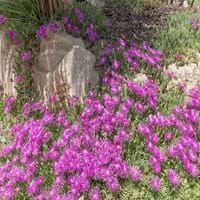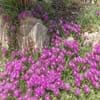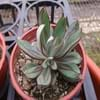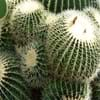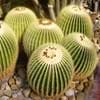Life Span
Perennial
Perennial
Type
Flowering Plants
Fruit
Origin
Southern Africa, South Africa
China
Types
Not Available
Actinidia deliciosa chlorocarpa, Actinidia deliciosa deliciosa
Number of Varieties
Not Available
Habitat
By seashore, gardens
Mountain forests
USDA Hardiness Zone
Not Available
6-9
AHS Heat Zone
Not Available
9-7
Sunset Zone
Not Available
4, 5, 6, 7, 8, 9, 12, 14, 15, 16, 17, 18, 19, 20, 21, 22, 23, 24
Habit
Not Available
Vining/Climbing
Minimum Height
Not Available
Flower Color
Not Available
Light Yellow, Ivory
Flower Color Modifier
Not Available
Bicolor
Fruit Color
Non Fruiting Plant
Tan, Brown
Leaf Color in Spring
Not Available
Green, Light Green
Leaf Color in Summer
Not Available
Green
Leaf Color in Fall
Not Available
Light Green, Yellow green
Leaf Color in Winter
Not Available
Light Green
Leaf Shape
Succulent
Heart-shaped
Plant Season
Spring, Summer, Fall, Winter
Spring, Summer, Fall
Sunlight
Full Sun, Partial Sun
Full Sun, Partial Sun
Growth Rate
Not Available
Fast
Type of Soil
Not Available
Clay, Loam
The pH of Soil
Not Available
Acidic, Neutral
Soil Drainage
Well drained
Average
Bloom Time
Not Available
Late Spring, Early Summer
Tolerances
Not Available
Drought
Where to Plant?
Container, Ground, Pot
Ground
How to Plant?
Stem Planting, Transplanting
Layering, Softwood cuttings
Plant Maintenance
Medium
Medium
Watering Requirements
Average Water Needs, Do Not over Water, Never Over-water, Requires watering in the growing season
Water daily during growing season
In Summer
Average Water
Lots of watering
In Spring
Average Water
Moderate
In Winter
Average Water
Average Water
Soil pH
Not Available
Acidic, Neutral
Soil Type
Not Available
Clay, Loam
Soil Drainage Capacity
Well drained
Average
Sun Exposure
Full Sun, Partial Sun
Full Sun, Partial Sun
Pruning
Remove damaged leaves, Remove dead branches, Remove dead leaves
Prune for shortening long shoots, Prune in early summer, Prune in late winter
Fertilizers
All-Purpose Liquid Fertilizer
Self-fertile
Pests and Diseases
Red blotch
Armillaria root rot, Armored scales, Bleeding canker, Botrytis Blight, Crown gall, Nematodes, Phytophthora Root Rot, Red blotch
Plant Tolerance
Drought
Drought
Flower Petal Number
Single
Single
Showy Fruit
Not Available
No
Edible Fruit
Not Available
Yes
Fragrant Fruit
Not Available
Yes
Fragrant Leaf
Not Available
No
Fragrant Bark/Stem
Not Available
No
Showy Foliage
Not Available
No
Showy Bark
Not Available
No
Foliage Texture
Bold
Medium
Foliage Sheen
Not Available
Matte
Self-Sowing
Not Available
No
Attracts
Butterflies
Not Available
Allergy
Not Available
Inflammation, Mouth itching, Throat itching
Aesthetic Uses
Beautification, Bouquets, Cottage Garden, Decorating walls, Ground Cover, Landscape Designing, Showy Purposes, Used for decorating walls, fences, gates, hedges, etc.
Not Used For Aesthetic Purpose
Beauty Benefits
Not Available
Beautiful Skin, Protects from sun damage
Environmental Uses
Food for insects
Air purification
Medicinal Uses
No Medicinal Use
constipation, Heart problems, Low Blood Pressure
Part of Plant Used
Flowers
Fruits
Other Uses
Decoration Purposes, Showy Purposes, Used as Ornamental plant
Used As Food, Used for its medicinal properties
Used As Indoor Plant
No
No
Used As Outdoor Plant
Yes
Yes
Garden Design
Container, Edging, Groundcover, Mixed Border, Rock Garden, Wall
Edible, Fruit / Fruit Tree, Rock Garden / Wall, Vine
Botanical Name
DELOSPERMA
ACTINIDIA deliciosa
Common Name
Trailing Iceplant
Chinese Gooseberry, Fuzzy Kiwi, Kiwi
In Hindi
Delosperma cooperi
कीवी फल
In German
Mittagsblume
Kiwi, Chinesischer Strahlengriffel
In French
Delosperma cooperi
Kiwi, Groseille de Chine, Yang Tao, Souris végétale
In Spanish
Delosperma cooperi
kiwi, kivi, actinidia
In Greek
Delosperma cooperi
Ακτινίδια
In Portuguese
Delosperma cooperi
Quiuí
In Polish
Delosperma cooperi
Owoc kiwi
In Latin
Delosperma cooperi
Kiwi fructum
Phylum
Not Available
Magnoliophyta
Class
Magnoliopsida
Magnoliopsida
Order
Caryophyllales
Ericales
Family
Aizoaceae
Actinidiaceae
Genus
Caryophyllales
Actinidia
Clade
Angiosperms, Core eudicots, Eudicots
Angiosperms, Asterids, Eudicots
Tribe
Not Available
Not Available
Subfamily
Ruschioideae
Not Available
Season and Care of Delosperma cooperi and Kiwifruit
Season and care of Delosperma cooperi and Kiwifruit is important to know. While considering everything about Delosperma cooperi and Kiwifruit Care, growing season is an essential factor. Delosperma cooperi season is Spring, Summer, Fall and Winter and Kiwifruit season is Spring, Summer, Fall and Winter. The type of soil for Delosperma cooperi is Not Available and for Kiwifruit is Clay, Loam while the PH of soil for Delosperma cooperi is Not Available and for Kiwifruit is Acidic, Neutral.
Delosperma cooperi and Kiwifruit Physical Information
Delosperma cooperi and Kiwifruit physical information is very important for comparison. Delosperma cooperi height is Not Available and width Not Available whereas Kiwifruit height is 610.00 cm and width Not Available. The color specification of Delosperma cooperi and Kiwifruit are as follows:
Delosperma cooperi flower color: Not Available
Delosperma cooperi leaf color: Not Available
Kiwifruit flower color: Light Yellow and Ivory
- Kiwifruit leaf color: Green and Light Green
Care of Delosperma cooperi and Kiwifruit
Care of Delosperma cooperi and Kiwifruit include pruning, fertilizers, watering etc. Delosperma cooperi pruning is done Remove damaged leaves, Remove dead branches and Remove dead leaves and Kiwifruit pruning is done Prune for shortening long shoots, Prune in early summer and Prune in late winter. In summer Delosperma cooperi needs Average Water and in winter, it needs Average Water. Whereas, in summer Kiwifruit needs Lots of watering and in winter, it needs Average Water.
